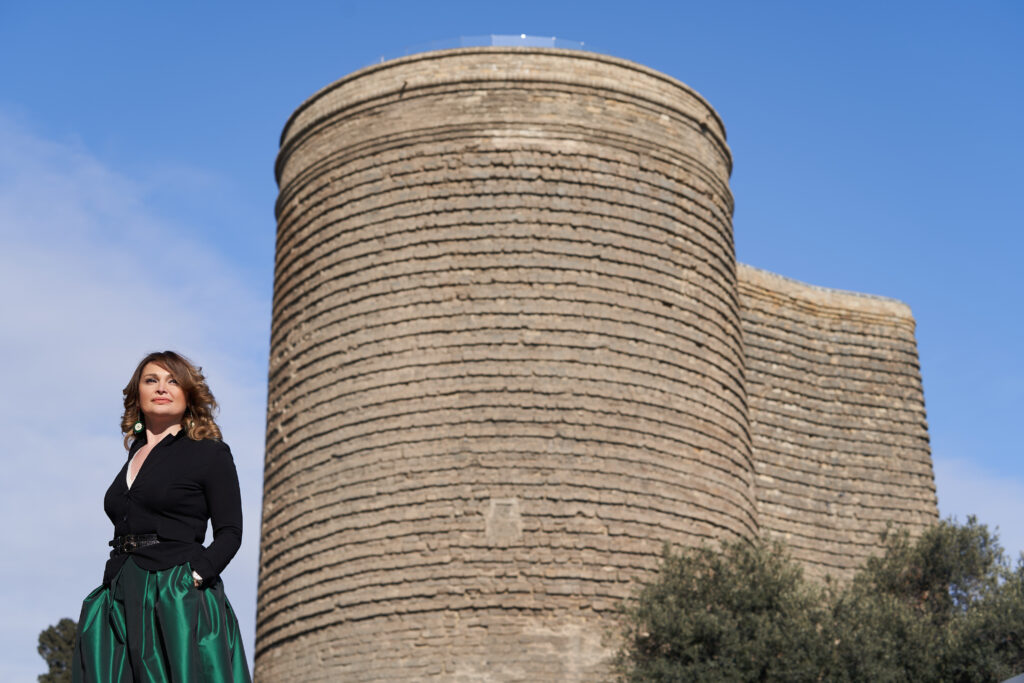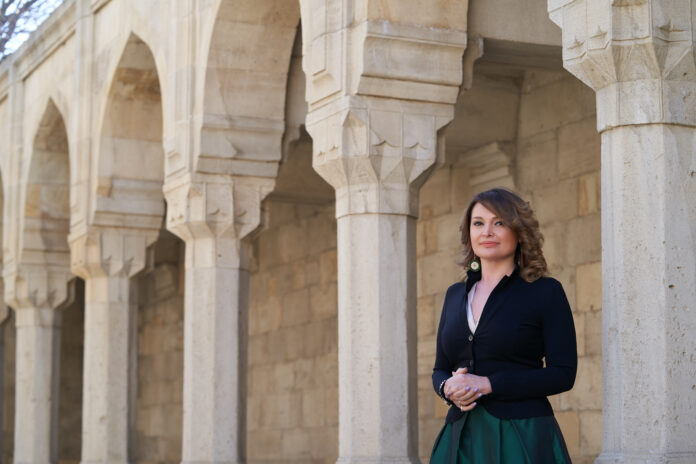THE ACTIVITY OF THE DIRECTOR OF THE ICHERISHEHER (OLD CITY) MUSEUM CENTER, DOCTOR OF PHILOSOPHY IN ART HISTORY, HONORED WORKER OF CULTURE, MRS. AMINA MELIKOVA, IS RESPONSIBLE FOR PRESERVING AND FURTHER DEVELOPING THE AZERBAIJANI PEOPLE’S GREAT HERITAGE. BEING A LAUREATE OF HUMAY NATIONAL PRIZE FOR HER BOOKS, “THE HERITAGE OF THE SHIRVANSHAHS IN THE WORLD MUSEUMS” AND “THE ART OF KELAGHAYI”, SHE TELLS AZERI OBSERVER ABOUT THE ROLE OF THE SHIRVANSHAHS DYNASTY IN AZERBAIJAN’S HISTORY, AND THE ART OF MAKING AND WEARING THE TRADITIONAL AZERBAIJANI SILK HEADSCARVES. SHE ALSO SHARES SOME ICHERISHEHER’S LEGENDS, TALKS ON ITS NEW EXHIBITS, AND EXPLAINS HOW THE MUSEUM MEETS THE DEMANDS OF MODERN TIME.
BY RAYA ABBASOVA
AZERI OBSERVER CONTRIBUTOR
Question: All your activities are related to museums. How did you come to this specialty?
Answer: My professional choice didn’t happen by chance. I grew up in the family of an employee of the Azerbaijan State Theater Museum located in the Nizami Museum. Every day after classes I couldn’t wait to visit the museum which showed me the infinite world of theatrical art. That is how I learned the cultural history of the national theatre. In the 1990s, the museum’s exhibition moved to the majestic building of the Museum Center.
Looking back over the years, I understand that I was predestined to work in this sphere. Having a degree in Economics, I have been working in museums for 20 years. My career started in 1999, when the Museum Center opened an exhibition gallery, where various artists could expose their works. Ten years of work at the Center taught me a lot about the world of art. Later on, I was promoted to the head of the international relations and cultural development department. It was a period of many trips, international events and, of course, vivid impressions. In 2009, the first building of the Museum of National Art opened after restoration, and I was invited to head the department of innovation and international relations, which met my professional interests, and at the same time contributed to my development as a museum worker. I liked this job, but after some time I realized that it was important to constantly grow and strive for new horizons. The Icherisheher open-air museum seemed to me such a horizon, as it required broader knowledge and skills, interesting initiatives and a different rhythm of life. It is understandable as the Icherisheher is a living organism with its own life scheme, inhabitants, infrastructure, etc.
Q.: How do you feel when you enter the fortress walls and find yourself in the Icherisheher – the inner sanctum of our country?
A.: Every time is different. The space of Icherisheher is a mystery! Sometimes it seems to me that I have studied every corner here, but next time I take another route to work and discover something new. I will not conceal that some places are especially significant for me, and I perceive them as meaningful symbols. For example, a pistachio tree in the middle courtyard of the Shirvanshahs’ Palace. In the East, pistachio is called a “tree of life”, as it symbolizes abundance and prosperity. A legend says that the tree was planted by the wise politician and diplomat, Sheikh Ibrahim I, on the occasion of the birthday of his son, Shirvanshah Halilullah I, at the beginning of the 15th century, and is reborn every 100 years. We can assume that with the named tree, the father blessed his son for success and prosperity, which is proved by the history. During the reign of Halilullah I ibn Sheikh Ibrahim (1417-1465), construction flourished in the country and the main part of the Shirvanshahs’ Palace ensemble in Baku was erected, as well as numerous caravanserais, baths, ovdans [Ed. note: water reservoir or well] and other objects throughout Shirvan [Ed. note: a region in Azerbaijan, ruled by the Shirvanshahs’ dynasty]. A kind of academy was created at the palace of Halilullah I in Baku, where scientists and philosophers from all over Azerbaijan worked. Defending his native land, Shirvanshah Halilullah I repeatedly showed legendary valor, bravery and courage in battles against his enemies.

Q.: You are telling us a story which does not just go back in time, but covers an important period in the history of Azerbaijan.
A.: I enrich my knowledge thanks to my work, a huge personal interest in the history of our country, and the numerous events, which we host in the Icherisheher Reserve Museum. I am very lucky to work here, especilly in the period of the preparations for “The Heritage of the Shirvanshahs in the World Museums” exibition – a very important project for all Azerbaijani citizens, aimed at preserving the Shirvanshahs’ heritage.
Q.: The state of the Shirvanshahs’ with their achievements in various spheres left a bright mark in history, and it undoubtedly, deserves close attention…
A.: That is what the above-mentioned exhibition proved once again. It enhanced our understanding of the importance of the 1000-year period of the Shirvanshahs’ dynasty’s rule. I would like to mention a truly unique fact: the state of the Shirvanshahs’ was always independent – no country in the Islamic east showed such stability. The State Historical and Architectural Reserve Icherisheher jointly with the Azerbaijan’s National Academy of Sciences organized the international scientific conference, “Journey from modern Azerbaijan to the Historical State of the Shirvanshahs”, timed to the exhibition. At the same time, a Forum of Young Scientists, a presentation of the documentary film, “Shirvan’s Shahs”, and, “Ruined, destroyed monuments and the Shirvanshahs’ throne” scale model contest, took place in Baku.
Q.: How do you manage to recreate historical objects so close to the original?
A.: It requires very scrupulous work based on scientific research, ancient narratives and legends, and rare exhibits. Documentary materials – photographs, letters, memories of people passed over generations, for example, are of great help in this issue. Here, I would like to note that our museum has a small, but very rare jewelry collection, and we continue to replenish it. In 2019, we managed to purchase head jewelries made by master jewelers from the northwestern regions of Azerbaijan, and just recently, acquired a silver set of bride jewelry in excellent condition. We have ancient weapons, well-preserved Shirvan carpets, and an antique collection of unique samovars. Every new rare exhibit makes us immensely happy, as it is another opportunity to reveal the secrets of the past.
Q.: I had an opportunity to read your wonderful book, “The Heritage of the Shirvanshahs in the World Museums”, which will be interesting for a wide audience.
A.: Thank you. The published book is one of the ways to promote the Shirvanshahs’ heritage. Within the framework of the afore-mentioned international scientific conference, “Journey from modern Azerbaijan to the Historical State of the Shirvanshahs”, an exhibition of museum exhibits of the Shirvanshahs’ era was organized. Visitors could see, in particular, Shirvanshah Halilullah I’s chain armor with engraved blessings. This relic and other exhibits of the Shirvanshahs’ period from the collection of the Istanbul Military Museum, were exhibited in Baku for the first time – the only city in the world where a historical Shirvanshahs’ Palace still exists. I would also like to note that the Azerbaijan’s National Museum of History keeps a large collection related to the Shirvanshahs. A gem of this collection is a brooch with rubies and turquoise from the tomb of Bikya-khanum (the mother of Shirvanshah Halilullah I and wife of the founder of national diplomacy, Shirvanshah Sheikh Ibrahim) – the only gold jewelry of that period, which survived from that time. As you may see, everything is interconnected – mentioning of the pistachio tree took us deep into the history of our country, rich in glorious events and names. We can be proud of it.

Q.: While visiting Baku, many foreign celebrities, official people and tourists admire the beauty of Azerbaijan’s capital and its respect for historical monuments. For example, just recently, the Icherisheher open-air museum’s collection was replenished with more restored sites.
A.: You probably mean the park area of the Baku Khans’ Palace Complex and the underground bath of the 17th century, discovered during archaeological excavations on the territory of Icherisheher, near Gosha Gala gate in 2016. President of Azerbaijan, Ilham Aliyev and First Lady, Mehriban Aliyeva, whose personal attention and contribution to the preservation of national history and to giving many historical sites a world-class heritage status, inspire deep respect and admiration, took part in the opening ceremony of these sites, which proved their importance once again.
Q.: One can think that it is just a bath, however, baths have a special place in people’s lives in the East. Would you agree?
A.: I would also like to draw your attention to the fact, that the main part of this bath is underground. Such a solution, as well as a hemispherical dome crowning the structure, keep a constant temperature and create the best environment. Moreover, the construction of baths was considered a godly deed, as water, according to legend, washes sins away. “Whoever has committed many sins should build a bath to wash them away,” the Arab writer, Yusuf Abdalhadi said. Baths were multifunctional. It was a place where people held business negotiations, exchanged information; older women chose brides for their sons and relatives. While going to a bathhouse, girls put on their best outfits and jewelry in order to see and to be seen. So, it was a place focused on traditions and rituals! People of art – writers, poets, artists, for example, mention baths in their works quite often, sometimes even with satirical tone.
As for the park in the Baku Khans’ Palace Complex, it has become one of the favorite rest areas for Baku residents and guests of our city in a relatively short time.
It is worth mentioning that Icherisheher was declared a historical and architectural reserve in 1977. In 2000, it became the first site from Azerbaijan included in the UNESCO World Heritage List, together with the Shirvanshahs’ Palace. In 2018, restoration and reconstruction of the palace complex was initiated by the first Vice President of Azerbaijan, Mehriban Aliyeva, which was carried out by the Administration of the State Historical-Architectural Reserve. Now, we are proud to say that our Old City (as we sometimes call Icherisheher) remains eternally young over the years. The organic fusion of antique buildings and the panorama of the modern, beautiful city of Baku outside the Icherisheher’s ancient fortress walls, makes the capital of Azerbaijan totally unique.
Q.: As a highly experienced museum worker, what would you recommend to do to keep the local population interested in our history? We are not talking about tourists, as they have always visited and will always visit Icherisheher with great interest.
A.: We should be able to adapt to the requirements and even the whims of an era. A museum should not be a structure frozen in time, but an organism capable of keeping up with the times, thanks to the efforts of professionals. For example, in the Baku Khans’s Palace, every visitor can feel like a traveler in time. The palace allows us to understand the history of our Motherland and people from the 15th, until the beginning of the 20th century. This amazing journey is supplemented with audio guides, captivating visitors with professional commentaries, themed room spaces, a full-length historical film, etc. Today, Icherisheher has a new strategy of museum work, which includes innovative solutions, based on advanced Western technologies.

Q.: The country’s museums, like many other cultural organizations, have fallen on hard times during the pandemic. It is with great foresight that many of them, including your museum, worked proactively online during the toughest quarantine, which helped people to ‘perk up’ while being stuck at home. Will Icherisheher continue its virtual tours online after the full opening?
A.: The present time requires active implementation of modern technologies. Every epoch has its own rules. That is why museum workers should work hard to make our expositions interesting for a wide audience of all ages. The current trending of the time should always be on the agenda. If young people prefer the digital format, we must meet the requests of our potential visitors. It is true that real live communication cannot be substituted. However, we have witnessed that we can find ourselves in unforeseen circumstances, which means that museums should be flexible in terms of presenting their collections. Progress is a great thing!
Q.: Could you tell us about your book, The Art of Kelaghayi, which is about traditional Azerbaijani women’s headgear. I have seen your photos wearing the amazingly beautiful Kelaghayis, which makes me wonder if these headscarves make a woman, a Woman?
A.: The efforts of the Heydar Aliyev Foundation and Azerbaijan’s Ministry of Culture helped to include “the Traditional art and symbolism of Kelaghayi, making and wearing women’s silk headscarves”, in the Representative List of the UNESCO Intangible Cultural Heritage of Humanity in 2014. It gave me an idea to create a book that would reflect the history and variety of the unique national headscarf. After a 4-year period of work, the book was published in three languages –Azerbaijani, Russian and English, being the first book about kelaghayi in English. The author of the first concept about kelaghayi, Rena Ibrahimbekova, was the editor-in-chief, who also provided me with basque patterns reflecting the ancient philosophy of the Azerbaijani people. At the presentation of the book at the Carpet Museum, we had a dress-code requiring all the invited women to wear kelaghayi, and it seemed liked a real flower garden – full of femininity, beauty, a wide range of colors and patterns. Moreover, the headscarves emphasized the individuality of every person! If you asked me your question that day, with all the emotions I had, I would have said, “Kelaghayi makes a woman, a Woman!” In reality, everything is much more complicated. Being a woman is a great art, which should be mastered. And yet, there is one well-known secret: what makes a woman, a Woman, is the ability to love without losing yourself, set certain goals, meet them and move on. It is important to strive for the best, develop your personal qualities, your potential, but not to lose your personality on sharp turns. It is a great happiness to be yourself in the process of the quest for self-expression. If you are happy, everyone around you is also happy! One should remember this, and this is something I always try to do.



















